List of siege engines
This is a list of siege engines invented through history. A siege engine is a weapon used to destroy fortifications such as defensive walls, castles, bunkers and fortified gates.
By age, oldest to newest
| Name | Image | Date | Location | Notes |
|---|---|---|---|---|
| Siege tower | 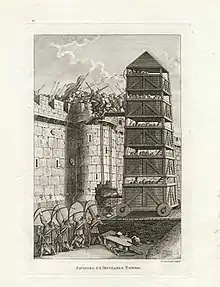 |
9th Century BC | Assyria | A giant mobile tower, often constructed at location. |
| Battering ram | 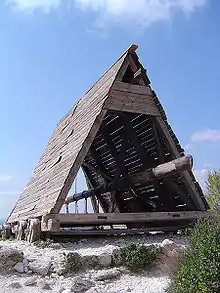 |
9th Century BC | Assyria | First siege engine recorded to be used, soon adopted by Sparta.[1] |
| Catapult | 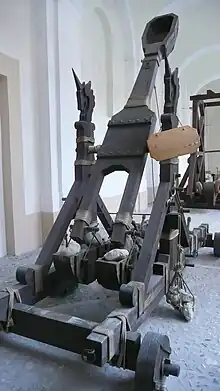 |
500 BC | India | A signature siege engine, used until World War I.[2] |
| Ballista | 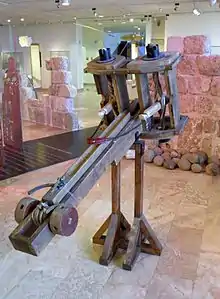 |
400 BC | Syracuse, Sicily | A very large and powerful crossbow. Could be mounted on carts. Similar weapons mounted on elephants were used by the Khmer Empire.[3] |
| Onager | 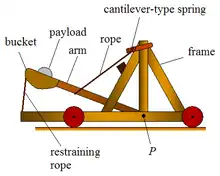 |
353 BC | Rome | The Onager was a Roman torsion powered siege engine. It is commonly depicted as a catapult with a bowl, bucket, or sling at the end of its throwing arm. |
| Trebuchet |  |
4th Century BC | China | Similar to the catapult, but uses a swinging arm to launch projectiles. It is usually considered to be stronger than the catapult.[4] |
| Helepolis |  |
305 BC | Rhodes | Roman siege tower first used in Rhodes.[5] |
| Siege hook | 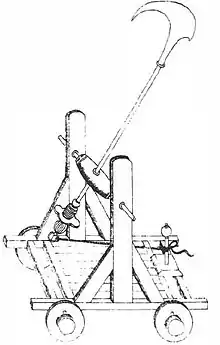 |
2nd Century BC | Rome | A siege hook is a weapon used to pull stones from a wall during a siege. The method used was to penetrate the protective wall with the hook and then retract it, pulling away some of the wall with it. |
| Sambuca |  |
213 BC | Sicily | Roman seaborne siege engine build on two ships. |
| Scorpio |  |
52 BC | Gaul | Similar to the ballista, but smaller. Was sometimes mounted on a mule-drawn cart.[6] |
| Cheiroballistra |  |
Alexandria | A Roman imperial era siege engine designed by Hero of Alexandria and mostly composed of metal. It shot bolts that were smaller than those in other forms of ballistae and was the next major improvement after the scorpio. | |
| Catapulta | Rome | A Roman siege engine for throwing arrows and javelins. The name comes from the Greek katapeltes because it could pierce or 'go through' (kata) shields (peltas). The catapulta was made of wood and were placed on stands. | ||
| Mangonel |  |
6th Century AD | China | A type of trebuchet which used traction. |
| Springald | 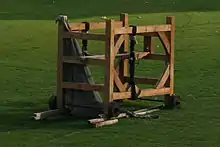 |
11th century | Byzantium | An inward shooting piece of siege equipment.[7] |
| Artillery | 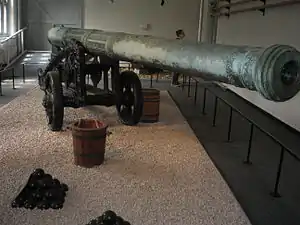 |
First seen in 14th century, only called artillery around the 15th and 16th century [8] | China | After the invention of gunpowder in China, the ability to create firearms and siege artillery was open, siege technology advanced from here but, under the artillery category. There is fewer use for this kind of technology today after the invention of rockets and high grade explosives.[9] |
Further reading
References
- "The Battering Ram - lordsandladies". Retrieved 24 May 2017.
- Baintighearn Aimiliona Tevnane CW. "Catapult History and Modern Day Construction - midrealm". Retrieved 25 May 2017.
- "Ballista - lordsandladies". Retrieved 24 May 2017.
- "Trebuchet - lordsandladies". Retrieved 24 May 2017.
- Article by James Yates, M.A., F.R.S. (6 August 2012). "Helepolis - A Dictionary of Greek and Roman Antiquities, John Murray, London, 1875". Retrieved 25 May 2017.
{{cite web}}: CS1 maint: multiple names: authors list (link) - Vegetius, De re militari, II, 25.
- Nicolle, pp. 173–174, the espringal is depicted, in the form of a fairly detailed diagram, in an 11th-century Byzantine manuscript
- Andrew Knighton (25 November 2015). "12 Key Moments in the History of Artillery". Retrieved 21 October 2017.
- Ian Vernon Hogg (28 December 2011). "Artillery". Retrieved 21 October 2017.
This article is issued from Wikipedia. The text is licensed under Creative Commons - Attribution - Sharealike. Additional terms may apply for the media files.